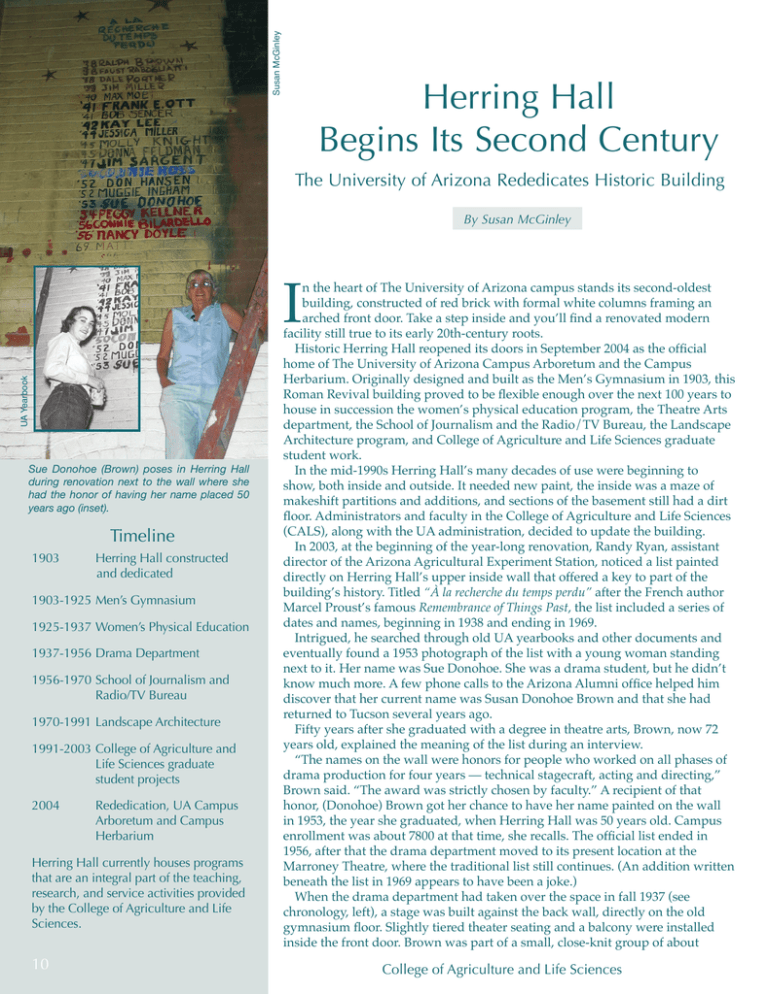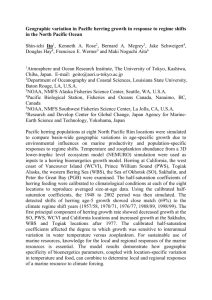I Herring Hall Begins Its Second Century
advertisement

Susan McGinley Herring Hall Begins Its Second Century The University of Arizona Rededicates Historic Building By Susan McGinley UA Yearbook I Sue Donohoe (Brown) poses in Herring Hall during renovation next to the wall where she had the honor of having her name placed 50 years ago (inset). Timeline 1903 Herring Hall constructed and dedicated 1903-1925 Men’s Gymnasium 1925-1937 Women’s Physical Education 1937-1956 Drama Department 1956-1970 School of Journalism and Radio/TV Bureau 1970-1991 Landscape Architecture 1991-2003 College of Agriculture and Life Sciences graduate student projects 2004 Rededication, UA Campus Arboretum and Campus Herbarium Herring Hall currently houses programs that are an integral part of the teaching, research, and service activities provided by the College of Agriculture and Life Sciences. 10 n the heart of The University of Arizona campus stands its second-oldest building, constructed of red brick with formal white columns framing an arched front door. Take a step inside and you’ll find a renovated modern facility still true to its early 20th-century roots. Historic Herring Hall reopened its doors in September 2004 as the official home of The University of Arizona Campus Arboretum and the Campus Herbarium. Originally designed and built as the Men’s Gymnasium in 1903, this Roman Revival building proved to be flexible enough over the next 100 years to house in succession the women’s physical education program, the Theatre Arts department, the School of Journalism and the Radio/TV Bureau, the Landscape Architecture program, and College of Agriculture and Life Sciences graduate student work. In the mid-1990s Herring Hall’s many decades of use were beginning to show, both inside and outside. It needed new paint, the inside was a maze of makeshift partitions and additions, and sections of the basement still had a dirt floor. Administrators and faculty in the College of Agriculture and Life Sciences (CALS), along with the UA administration, decided to update the building. In 2003, at the beginning of the year-long renovation, Randy Ryan, assistant director of the Arizona Agricultural Experiment Station, noticed a list painted directly on Herring Hall’s upper inside wall that offered a key to part of the building’s history. Titled “À la recherche du temps perdu” after the French author Marcel Proust’s famous Remembrance of Things Past, the list included a series of dates and names, beginning in 1938 and ending in 1969. Intrigued, he searched through old UA yearbooks and other documents and eventually found a 1953 photograph of the list with a young woman standing next to it. Her name was Sue Donohoe. She was a drama student, but he didn’t know much more. A few phone calls to the Arizona Alumni office helped him discover that her current name was Susan Donohoe Brown and that she had returned to Tucson several years ago. Fifty years after she graduated with a degree in theatre arts, Brown, now 72 years old, explained the meaning of the list during an interview. “The names on the wall were honors for people who worked on all phases of drama production for four years — technical stagecraft, acting and directing,” Brown said. “The award was strictly chosen by faculty.” A recipient of that honor, (Donohoe) Brown got her chance to have her name painted on the wall in 1953, the year she graduated, when Herring Hall was 50 years old. Campus enrollment was about 7800 at that time, she recalls. The official list ended in 1956, after that the drama department moved to its present location at the Marroney Theatre, where the traditional list still continues. (An addition written beneath the list in 1969 appears to have been a joke.) When the drama department had taken over the space in fall 1937 (see chronology, left), a stage was built against the back wall, directly on the old gymnasium floor. Slightly tiered theater seating and a balcony were installed inside the front door. Brown was part of a small, close-knit group of about College of Agriculture and Life Sciences husbandry professor, and William Pistor, UA veterinarian, used to visit her family at their home in Cananea, Sonora in the 1950s. Before that, Stanley, and William Pistor’s wife, Virginia, had attended Montana State with Brown’s parents. Stanley’s and Pistor’s names are inscribed on a plate near a petrified wood table outside Forbes. Brown’s inscription remains as well. The original stretch of wall containing her name is now preserved in a commemorative glass case upstairs in Herring Hall. Downstairs, in front of the arboretum office, a basketball hoop is mounted on the side of the elevator, over a shooting keyhole taped on the floor. And along the north and south walls, a wooden stairstep inlay moving diagonally from the floor to near the ceiling recalls the stadium seating. Herring Hall began its 101st year with a fresh look and a nod to the past. It may be unique in that it has been involved over a longer period of time with more programs and colleges than any other building on campus, except perhaps Old Main.v Contact Randy Ryan, (520) 621-1845 rryan@ag.arizona.edu Elizabeth Davison, Campus Arboretum, (520) 621-7074, edavison@ag.arizona.edu Steven McLaughlin, Campus Herbarium, (520) 621-7186, spmcl@ag.arizona.edu Randy Ryan 15-20 students who helped put on four productions a year, including historical dramas, comedies, and Shakespearean plays. “Almost all of them were challenging because we didn’t have much room behind the stage. There was just enough space to move from one side to the other,” Brown says. Although Herring Hall was never intended to be a theater, original architect David Holmes’s vision of an elegant building — even if it was supposed to be mainly for student athletes — made it work for that purpose. The open interior proved adaptable, if not always perfect, for UA basketball games; for acting; for broadcasting, writing and reporting; to architectural designing; and currently, to a sizeable collection of dried, pressed plants and fungi, and an arboretum headquarters. Understanding Herring Hall’s history as a functional and flexible interior space was important during the latest rehabilitation, which responded this time to the needs of the college while maintaining the historic integrity of the building. When the Forbes Building was constructed adjacent to Herring in 1915 for the College of Agriculture, students using the two buildings had the chance to interact. Brown actually knew some of the agricultural faculty anyway. Ernest Stanley, animal Newly renovated Herring Hall ARIZONA LAND PEOPLE History of Herring Hall Herring Hall was built in 1903 for $6,750, with $5,000 of that donated by the Copper Queen Mining Company. The gift was arranged by Colonel William Herring, legal counsel for the company, amd chancellor of the Arizona Board of Regents. The first floor of this small, red brick 40’ by 80’ building was constructed as an open gymnasium, which remains the character-defining space. A feasibility study done in 1999 by Burns and WaldHopkins determined that the building was capable of undergoing a complete rehabilitation, allowing adaptive reuse of the structure and continuing its useful and graceful presence on campus for many more decades. The interior, which now includes a second floor, includes administrative offices for the UA Campus Arboretum and the Campus Herbarium, along with its full collection of 450,000 vascular plant specimens, most of them pressed and mounted on sheets of archival paper, and the mycological collection, with 40,000 specimens. The Herbarium actually predates Herring Hall: it was established in 1890, the year before the University of Arizona opened. It now contains the largest collection of plants from the southwestern United States and northwestern Mexico. M3 Engineering and Technology Corporation, Architects and Engineers provided the design for the rehabilitation, and Tucson Building and Remodeling, Inc. provided the construction services. The School of Landscape Architecture, College of Agriculture and Life Sciences, and Campus Grounds Department collaborated on the landscape design for the renovated site. Funding for the Herring Hall Rehabilitation project was provided by the College of Agriculture and Life Sciences. Herring Hall is part of the UA’s West Campus Historic District, which was listed on the National Register of Historic Places in 1986. The completed renovation received a 2005 Governor’s Heritage Preservation Honor Award sponsored by the Arizona Preservation Foundation and Arizona State Parks. Herring Hall: cals.arizona.edu/herringhall/ Campus Arboretum: arboretum.arizona.edu Campus Herbarium: ag.arizona.edu/herbarium/ 11




